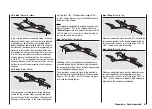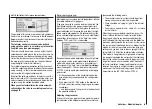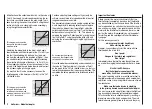
74
Heli mixer
Autorotation settings
Autorotation allows full-size and model helicopters to
land safely in a crisis, i.e. if the power plant should fail.
It can also be used if the tail rotor should fail, in which
case cutting the motor and carrying out an autorotati-
on landing is the only possible way of avoiding a high-
speed uncontrollable rotation around the vertical axis,
invariably terminating in a catastrophic crash. And that is
the reason why switching INTO autorotation occurs wit-
hout any delay.
When you switch to the autorotation phase the heli mi-
xer change as shown in this screen shot:
During an autorotation descent the main rotor is not dri-
ven by the motor; it is kept spinning only by the airfl ow
through the rotor plane caused by the speed of the des-
cent. The rotational energy stored in the still spinning ro-
tor can be exploited to allow the machine to fl are out, but
this can only be done once. For this reason “autos” are
only likely to be successful if the pilot has plenty of ex-
perience in handling model helicopters, and has also set
up the appropriate functions with great care.
Once you have suffi cient experience you should practi-
se autorotation landings at regular intervals, not only so
that you can demonstrate your all-round fl ying skill by
fl ying the manoeuvre in competitions, but also so that
you are in a position to land the helicopter undamaged
from a great height if the motor should fail. For this pur-
pose the program provides a range of adjustment facili-
ties which are designed to help you fl y your helicopter in
its unpowered state. Please note that the rotation setting
takes the form of a complete third fl ight phase, for which
all the adjustment facilities are available which can be
varied separately for all fl ight phases, especially trims,
collective pitch curve settings etc..
Ptch
(Collective pitch curve (Ch1
collective pitch))
In powered fl ight the maximum blade pitch angle is li-
mited by the motor power which is available; howe-
ver, in autorotation the angle is only limited by the point
at which the airfl ow over the main rotor blades breaks
away. Nevertheless, to provide suffi cient upthrust even
when rotational speed is falling off, it is necessary to
set a greater maximum collective pitch value. Press
SE-
LECT
or
ENTER
to select the graph page of “Collecti-
ve pitch”, and then move the vertical line to Point 5 using
the transmitter stick. Start by setting a value which is
about 10 to 20% higher than the normal collective pitch
maximum; any more than this, and the helicopter may
balloon up again during the fl are following the autoro-
tation descent. If this happens, the rotational speed of
the main rotor will quickly decline to the point where it
collapses, and the helicopter ends up crashing to the
ground from a considerable height.
Under certain circumstances the collective pitch mini-
mum setting may also differ from the normal fl ight set-
ting; this depends on your piloting style for normal fl ying.
In any case you must set a suffi ciently generous collec-
tive pitch minimum value at Point 1 to ensure that your
model can be brought from forward fl ight at moderate
speed into a descent of around 60 ... 70° when collective
pitch is reduced to minimum.
Most helicopter pilots already use such a setting for nor-
mal fl ying, and if this applies to you, you can simply ad-
opt the same value.
If the angle is too shallow, increase the value.
Approach angle
under varying wind
conditions.
For autorotation the collective pitch stick itself may not
be positioned right at the bottom of its travel; typically it
is between the hover position and the bottom end-point,
giving the pilot scope for correction if necessary, i.e. the
chance to adjust the model’s pitch inclination using the
pitch-axis control.
You can shorten the approach by pulling back on the
pitch-axis stick and gently reducing collective pitch, or
alternatively extend the approach by pushing forward on
the pitch-axis stick and gently increasing collective pitch.
Throttle
(throttle curve)
In a competition the pilot is expected to cut the mo-
tor completely, but for practice purposes this is certain-
ly not advisable. Instead set the throttle so that the mo-
tor runs at a reliable idle during autorotation, so that you
can open the throttle immediately to recover from an
emergency.
Tail rotor
(static torque compensation)
For normal fl ying the tail rotor is set up in such a way
that it compensates for motor torque when the helicopter
is hovering. This means that it already generates a cer-
tain amount of thrust even in its neutral position. The le-
vel of thrust is then varied by the tail rotor control sys-
tem, and also by the various mixers which provide all
manner of torque compensation, while the tail rotor trim
is also used to compensate for varying weather conditi-
Heli mixer / Autorotation – Model helicopter
Approach Angle
in strong
wind
in moderate
wind
no wind
45°
60°
75°
Summary of Contents for MX-16S
Page 1: ...1...
Page 17: ...17...
Page 31: ...31 Fixed wing models Installation and connections...
Page 35: ...35 Program description Reserving a new memory...
Page 47: ...47 Base settings Model helicopter...
Page 83: ...83 Fail safe...
Page 89: ...89 Programming examples Fixed wing model...
Page 109: ...109 Programming examples Model helicopter...
Page 112: ...112 112...
Page 116: ...116...
















































